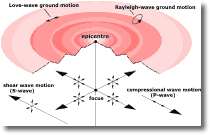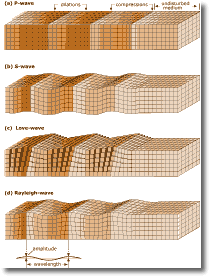Definition
of an Earthquake
Earthquakes are caused by a passage of earthquake waves or seismic
waves.
These waves are a form of energy which is usually released by a
sudden movement along a fault, or fracture plane in the crust
of the earth. When the earthquake occurs, seismic waves travel outwards
in all directions from the earthquake’s origin. The source of most
earthquakes is located in the earth’s crust which is about 50km
thick beneath the continents.
The point within the earth at which the seismic waves
are generated is called the focus of an earthquake. Once
the seismic waves reach the surface of the earth we feel them as
earthquakes – literally ground-shaking events. We also feel them
at different times and with different intensities at different locations.
This indicates that earthquake waves move with measurable speed
through the earth and their energy varies from place to place.
Earthquakes can be generated at any depth within the earth’s crust
and are classified according to their focal depth. The depth of
focus of shallow earthquakes is 0-60km; in intermediate
earthquakes focal depths are 60-300km; deep earthquakes have
focal depths of up to 700km. The energy generated by a shallow earthquake
is more likely to reach the surface with little modification than
energy generated by a deep earthquake. A small, shallow earthquake
may therefore have the same surface effect as a large, deep one.
Thus the amount of energy released at the focus of the earthquake
is going to be greater than the energy felt at a point on the earth’s
surface directly above the focus, the epicentre of the earthquake
(Fig 1). The deeper the earthquake the greater the energy
difference.
Types of seismic waves
Figure
1
 Earthquakes
are essentially the result of shock waves, or vibrations, that are
transmitted from a focus which can lie anywhere from 700km beneath
the Earth’s crust to its surface. There are two main kinds of seismic
waves; body waves and surface waves. Earthquakes
are essentially the result of shock waves, or vibrations, that are
transmitted from a focus which can lie anywhere from 700km beneath
the Earth’s crust to its surface. There are two main kinds of seismic
waves; body waves and surface waves.
Body waves comprise two types: (1) a compressional or primary wave
(P-wave) and (2) a shear or secondary wave (S-wave)
(Fig 1).
Figure
2
P-waves
spread out from the centre of an earthquake in a wave motion consisting
of alternating compression and dilation (Fig 2), a mechanism
similar to sound travelling through air. The velocity of P-waves depends
on rock density and rigidity and they are able to pass through the
entire earth, including the liquid outer core. Refraction of P-waves
at the core-mantle boundary produces two shadow zones on the opposite
side of the earth to the earthquake epicentre (Bryant 1991, p 195).
In these zones P-waves are undetectable. P-waves travel at the highest
velocities (5-6 km s-1), and reach seismographs first.
S-wave behaviour is similar to waves which develop in a rope
which has been shaken up and down (Fig 2). The rate of travel
of S-waves also depends upon rock density and rigidity. Because S-waves
are unable to pass through liquids they are unable to pass through
the earth's liquid outer core. This also creates a shadow zone on
the opposite side of the earth to the earthquake epicentre where S-waves
are not detected and which overlaps the P-wave shadow zone (Bryant
1991, p195). S-waves travel at 3-4 km s-1 and thus arrive at a seismograph
later than P-waves.
Surface waves (long waves, or L-waves) travel along
the earth’s surface and are trapped between the surface of the earth
and the shallow crustal layers below. L-waves are a little slower
than S-waves. They consist of many complex types, including the Rayleigh
wave, which behaves similarly to an ocean wave as particles through
which the wave travels describe an ellipse as the wave passes, and
the Love wave, in which particles slither back and forth in the crust
as it passes (Fig 2). L-waves usually have the strongest vibrations,
producing vigorous ground shaking and Love waves are responsible
for much of the damage caused by earthquakes.
|


